inverted veer
This series is a work-in-progress glossary of football concepts we tend to talk about in these pages. Previously:
Offensive concepts: RPOs, high-low, snag, covered/ineligible receivers, Duo, zone vs gap blocking, zone stretch, split zone, reach block, kickout block, wham block, Y banana play, TRAIN
Defensive concepts: Contain & lane integrity, force player, hybrid space player, no YOU’RE a 3-4!, scrape exchange, Tampa 2, Saban-style pattern-matching, match quarters, Dantonio’s quarters, Don Brown’s 4-DL packages and 3-DL packages, Bear
Special Teams: Spread punt vs NFL-style
------------------------------------------
So today we’re going to get into a play that we’ve discussed a ton on this site: The Inverted Veer, also called a Power Read. From 2011-2013 it was the Michigan offense’s best play (even if Borges might have run it incorrectly). Since 2012 it’s also been the staple play of Ohio State’s offense. If you close your eyes and think of a collegiate Tim Tebow or Cam Newton or Cardale Jones play where they fake handoff to the running back before a QB plunged straight ahead for an unstoppable 6-8 yards, that was probably an Inverted Veer.
WHAT IS IT?
The best way to think of it is the reverse of the zone-read option. Whereas Rich Rodriguez’s option play was all about reading the backside edge defender, Inverted Veer is about optioning a frontside guy.

Basically the QB and RB will option a frontside EMLOS (end man on the line of scrimmage) by having the RB jetting outside while the QB reads the unblocked end and decides to give it to his buddy as he passes, or if the DE leaves enough space, charging downfield.
That’s it. I showed power on the diagram because that’s probably the best way to block it, but you can run this successfully with a variety of blocking so long as the DL are all secured on the backside. Major variations on it are whether you go inside or outside of the last DT you blocked, and how you want your TEs and receivers and whatever other material to execute various stalk blocks, kickouts and cracks.
It’s also a sort of personnel reversal from a zone read. On ZR the running back ends up reading his blocks and finding an interior gap, while a QB keep puts the quarterback out in space. With Inverted Veer the RB is the one threatening to edge the defense while the quarterback is charging headlong into it. That last bit is why it’s such a great play for all of those truckstick quarterbacks I mentioned: Once the defense converges that big QB will have a lot of downhill momentum.
Course a jitterbug with ridiculous change of direction is cool too.
[Hit the JUMP for some good ol’fashioned bedreaded one fun]
Every time I post a play analysis these days there are a half-dozen people in the comments who mention that if player X did hard thing Y they are not prepared to do then the play would work. This has gotten to the point where I can explicitly prepare for such criticism and find them ignored, as in the most recent one, and find a diary on this site asserting that if player X did hard thing Y something would have worked.
This is extremely frustrating to me, because these are good-faith attempts to paint broader pictures of what I'm seeing down to down, game after game, year after year, as I try to figure out what Michigan football is doing. Various critics, most prominently Space Coyote, make a few small concessions and then go about explaining why play X was a good call and why it would have worked. They implicitly assert things like "Joe Kerridge in a ton of space should deviate from expecting Nebraska to use their slot LB as a force and ably block that guy when that LB believes the inverted veer is coming, has no need to respect the slot receiver because he is covered, and runs directly into Fitzgerald Toussaint."
I disagree with that. I have watched a lot of people play a lot of football and I think that's hard. I'm trying not to have a stance here; I am evaluating whether I think a thing is easy to do or hard and assigning a number to that feel. Coaches tend to think everything is an execution issue. Players should be able to do arbitrarily hard things. Some arrows on a diagram say this should work. Meanwhile I think there's a 10% chance for Kerridge to abort the plan and do anything with hell-for-leather blitzer and judge accordingly. Various guys dying on Borges Hill disagree.
I don't know what might be sufficient other than 175 yards against Nebraska to convince these guys that a poor offensive game plan can even exist, but here are various things that are normally too dull to post in a Picture Pages in which unblocked guys on blitzes obliterate Michigan runners for no or little gain.
These are representative of a larger slice of the game and a general feel that confirmed the Nebraska players' postgame assertions that they were expecting most of what Michigan threw at them. Tomorrow's Picture Pages will cover every play of the game, because this isn't going to work either.
One
Here is an iso. The slot LB is an eighth guy in the box and crashes down unblocked to tackle.
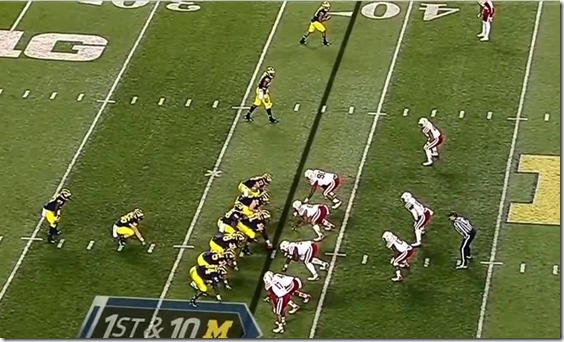

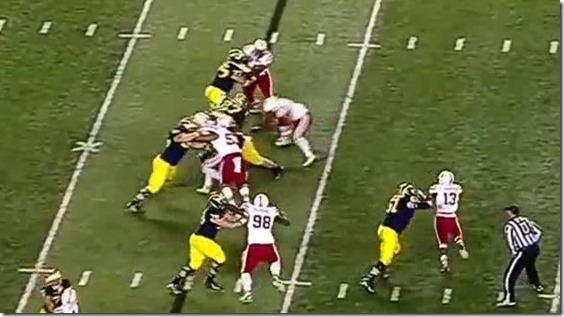
As this goes for three yards it qualifies as one of Michigan's best plays on the day on the ground. Three yards is not good on first and ten, and there was nothing Michigan could do about it.
Two
Here is a zone play. Nebraska loads up and sends a blitz through a gap that Michigan doesn't pick up as Bosch ends up doubling with Lewan.
However, because of the blitz the only thing Bosch making a very good play to recognize and pick up the charging LB does is send Green to one of the two unblocked guys, either the backside guy ripping down the LOS without thought of checking the QB or a linebacker sitting two yards deep without anyone trying to get him, because Nebraska's blitz has prevented anyone from moving to the second level.
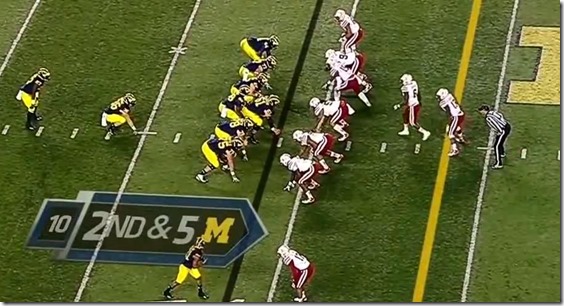
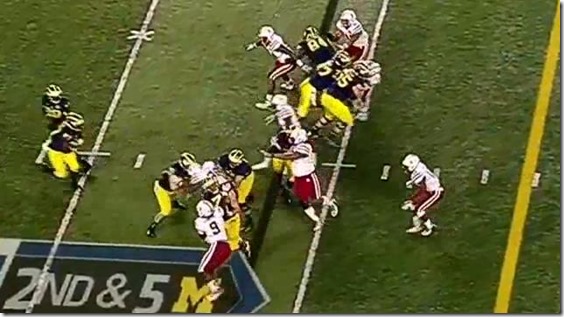
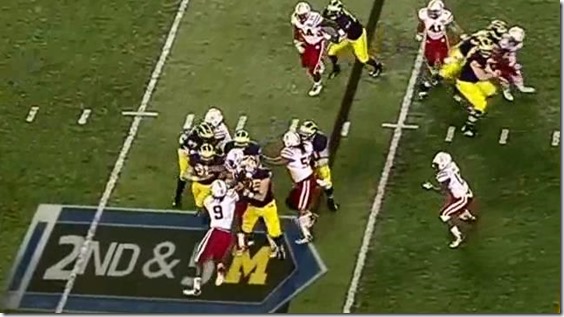
Three
Here is a power play. Nebraska loads up with eight in the box and one deep safety and blitzes.
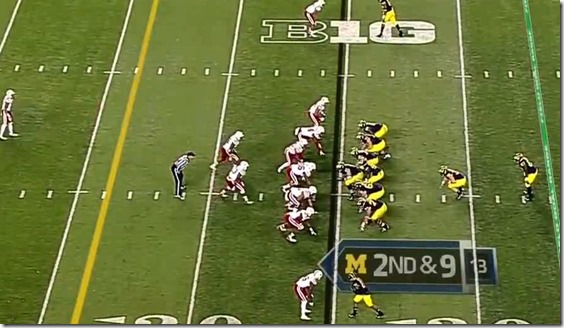
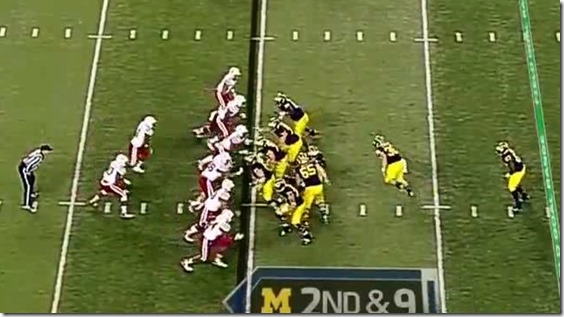
A Nebraska linebacker ends up shooting the gap behind the Bosch pull and meets Green in the backfield.
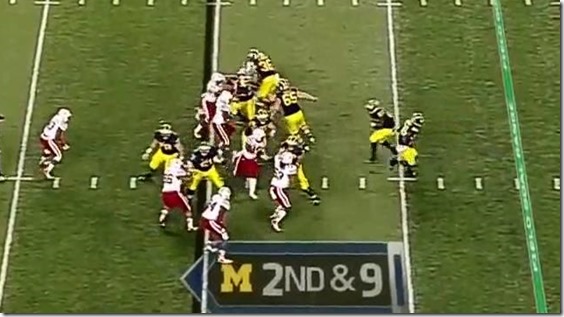
Michigan loses two yards and has third and eleven.
Four
Oh for pants' sake.
The offensive line is not in fact overwhelmed here; they are not actually involved because Nebraska's blitz is perfect to destroy the inverted veer.
Items Of Interest
All of this is an execution issue, sure. For a given definition of execution, this is an execution issue. Michigan's hyper-raw OL should be able to block this. They should be able to deal with Nebraska switching gaps and blazing LBs to the point of attack. They should be able to block Nebraska's maniacal run-oriented loaded box. They would do this, if only they could execute.
Except the last one. And the first one. And probably the second and third.
Either you believe that players can be put in positions they can succeed or players are expected to succeed in the positions they are put in. I am in the former camp. The last few Borges defenders are in the latter camp. This entire season Space Coyote has been gamely explaining what should have happened on failed play after failed play without any thought to how difficult what should have happened is.
Players do not exist in a vacuum. Joe Kerridge is trying to block a guy in acres of space and that guy has the jump on him because he knows Funchess is covered, and he knows what Michigan's running. I look at that and I think "Jesus, I do not want to be Joe Kerridge there."
I am admittedly working from a hand-waving feel on this, but it's no worse a feel than whatever Space Coyote has gotten from doing whatever he does with whatever team at a totally different level of competition. I say Michigan puts their players in a spot to work miracles or die, and that this is on both the overall structure of the offense and the predictability of playcalls based on formations and down and distance. Space Coyote makes certain concessions to not seem totally insane and then goes back to hammering the fact that it's all execution.
Kerridge was put in a spot to fail, and did. I'm looking at the play and saying I believe there is a small chance that Kerridge can make a tough play in space; the guys in the comments think that because Kerridge could hypothetically have made a play none of this goes back to the folks in charge.
These plays. The above plays are no-chancers for the offense, because Michigan is running into the teeth of a defense stacked to stop the run and blitzing. In UFR lingo they acquired sizeable rock-paper-scissors minuses. In compensation Michigan got two screens which both got large RPS plus numbers, but the number of downs thrown away in this game running at a Nebraska defense that seemed to be in Michigan's head was alarming. When I add it up, I am guessing things will come out highly negative, and then people will cluck at me about that.
I won't deny that things are more likely to get put in the negative bin there when you have fewer options because you're not good, but in my opinion running plays you suck at into stacked boxes is a bad idea. So is the continued deployment of Toussaint as a pass blocker on plays that take forever to develop. That, too, is an execution issue, but it is nuts to expect him to block guys now, and the offense would be better served if he was used in a pattern or replaced by a fullback or something. Instead… he is not.
But yeah yeah, the expectation is for the position.
Michigan couldn't get yard one with the veer against Nebraska, and most of them ended up with an unblocked Nebraska player blowing up Gardner. It is time to look at them. For some reason. Why didn't I start a blog about 1980s hairstyles? 1980s hairstyles never make you want to rub your face in gravel.
I digress. The first one comes on Michigan's first drive. A late blitz has just seen a power O slanted to and blown up for a one yard loss; it's second and eleven on the 24.
Michigan comes out with an H-back and two tailbacks in a twins formation, which necessarily means that the slot receiver is not an eligible receiver. Nebraska responds with 7.5 in the box, with the gray area defender just about splitting the difference between Funchess and the tackle.
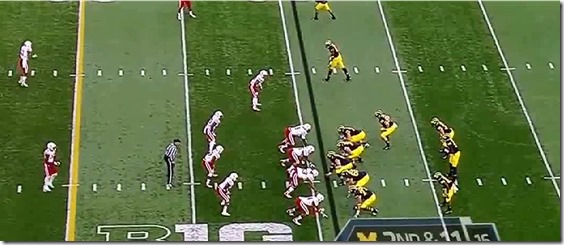
On the snap Bosch pulls and the gray area guy sits and stares the backfield down.
Michigan shows veer action with Kerridge leading Toussaint to the outside; Michigan blocks the playside end, which would mean they're expecting to option the slot defender except 1) Kerridge is out there, so they're using one of their blockers on him anyway and 2) Gardner does not appear to be reading him but something further inside, if he's in fact reading anything. Gardner's awareness of this slot defender seems to start after the mesh point.
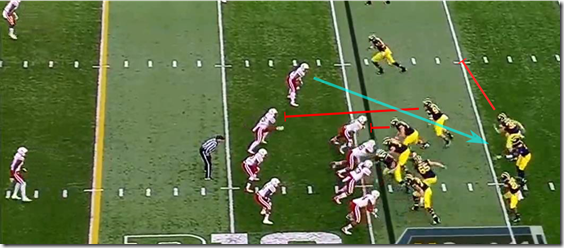
You can see that Gardner's helmet is not pointed at the slot defender as he starts making his decision:

What's he reading? Is he reading anything? I don't know. it doesn't seem like it. Watch the video in real time to get a feel for it. Toussaint does react like a guy who might get the ball, juking the blitzer, so I guess they're reading something. What is unclear.
Meanwhile, Kerridge is expecting the slot guy to contain upfield; instead he shoots upfield inside of him hard, too hard for him to adjust to.
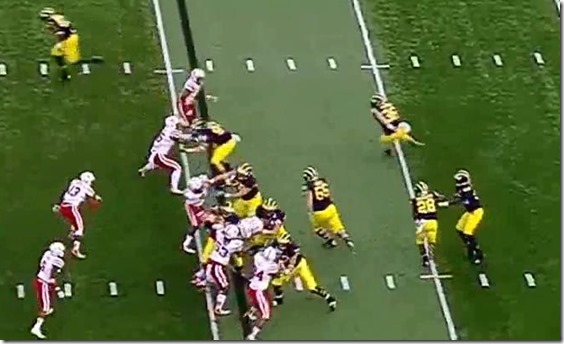
Gardner pulls and seems to sense a disturbance in the force now; he goes straight upfield.
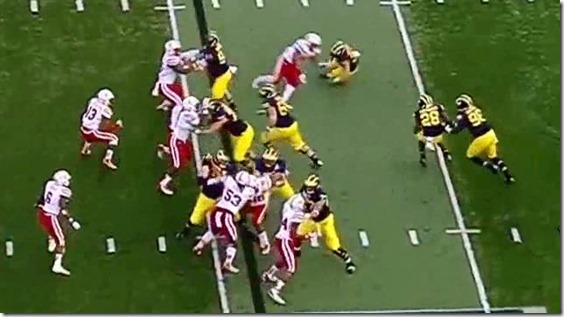
Toussaint dodges the blitzer, running into Gardner; Kerridge is prone, Gardner starts stumbling, and his momentum is taking him into the chest of an unblocked LB.
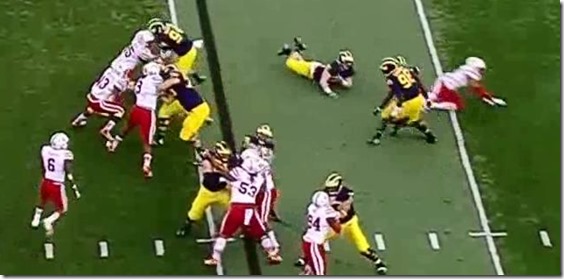
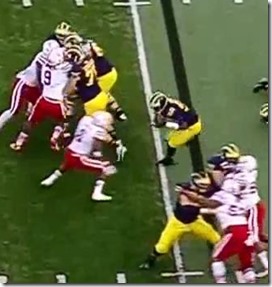
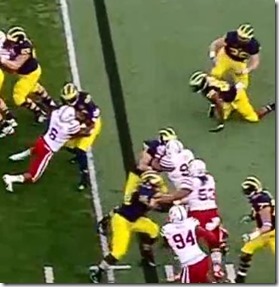
It's now third and nine, and Gardner's soul is now worn 1% more.
Video
Slow:
Items Of Interest
Optioning no one. We're back here, in year three. Michigan has a rudimentary read option game on which their QB doesn't know what to do too often and gets plays blown up, but here we're back to last year's Alabama game, where the defense made it so that Michigan's option plays didn't actually option off a defender, with similar results. No matter what happens on the edge here, the play still spends Kerridge and Toussaint on one defender and leaves an unblocked guy.
It would be one thing if I'd ever seen this fullback on the edge thing work. I have not. At best it's wasted him as he blocks a guy shooting up on the edge who is trying to contain Toussaint; at worst:
I'm about to get some comments about how this is Gardner's issue or Kerridge's issue and that Borges can't be held responsible for the results of this play. Sure. Any one play can be traced back to some execution error by the offense.
These posts are an effort to explain trends I'm seeing in the offense with particular plays, though, and this kind of half-ass option is par for the course. Michigan cannot get the fullback to be useful on these read option plays, and hasn't made him useful for three solid years.
![option-3_thumb[1] option-3_thumb[1]](https://mgoblog.com/sites/mgoblog.com/files/images/Picture-Pages_130F5/option-3_thumb1.png)
This is the kind of stuff Denard papered over by being Denard. Even when Michigan was eviscerating Ohio State two years ago, they weren't really optioning anyone and it was left to Denard to make the magic happen against an unblocked dude at the LOS:
Michigan was fortunate that was a freshman Ryan Shazier on one leg. When you don't have Denard and you've turned your quarterback's ribs into a fine paste already, you no longer get 41 yard touchdowns and instead your unblocked dude gets a tackle for minimal gain, or more likely a loss.
They've had Kerridge for three years now and Gardner that long and Toussaint that long and they still can't get them to execute a real option. Either they're not trying or they're not coaching. And either way…
How is this supposed to work? It seems like the idea here is for the slot guy to run himself upfield outside of Kerridge to maintain a force back inside and then for Gardner to hit the gap between him and the rest of the defense. Nebraska beats that idea by using the slot guy super-aggressively.
How do you make this play work? Nebraska understood that Michigan's formation meant Funchess was not eligible; the gray area defender had no thought of a pass and ended up blowing up the play. But you can still make this work since Nebraska is sitting so deep with the safeties. Michigan has two options here: shooting Kerridge at the LOS, leaving Toussaint to his own devices, or using Kerridge to attack the slot defender and put Toussaint on the edge into acres of space.
This is the kind of thing you could come back to later with a tweak and bust a big gain. Clearly there were no big gains on this day. This design isn't necessarily bad; the inability to see what Nebraska is doing and get rock to their scissors at some point is. I mean, if you get this again and block the dude the defense has no force player, which means you get a lot of yards. This move by Nebraska violates a cardinal tenet of sound defense and works because they win on RPS, and if you probe at what they're doing here you can beat that. Instead Nebraska just kept chewing up Michigan's offense.
Hooray covered slot receiver. Hooray. I will never understand the point of that. If Michigan had some package where the ability of the H-back to get to the backside of the play meant something, okay. Instead you get nothing and if the D recognizes it, as they seem to here, you're playing 10 on 11. Temporary voluntary red card.
Again, maybe this is some sort of genius but since I've never seen it do anything productive it just seems dumb.
29